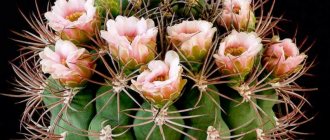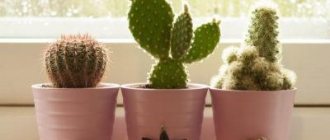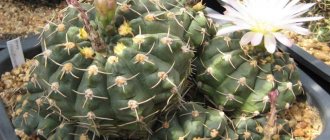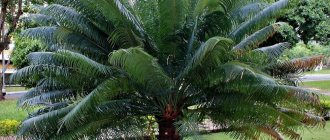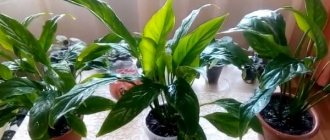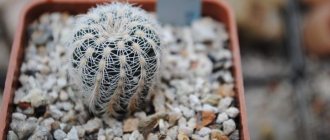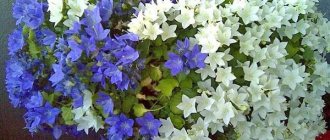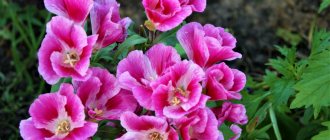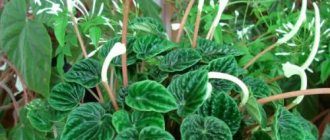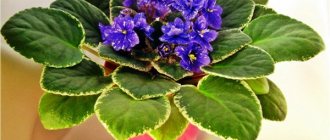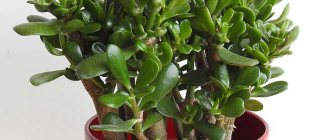Encyclopedia of Succulents
Cacti are prickly bushes that previously impressed almost no one. But now the fashion for these plants has become so popular that almost every gardener is ready to take on growing such crops. This is not surprising, because ease of care and attractive flowering do everything to make these plants become more and more popular. The Gymnocalycium cactus has an original appearance and incredible flowers. This article is devoted to the features of planting, caring for such a bush, as well as varieties of culture.
- 1 Description of the cactus genus Gymnocalycium
- 2 Gymnocalycium cactus: home care 2.1 Features of culture transplantation
Botanical description
The houseplant Gymnocalycium denudatum in Latin is a representative of the genus Gymnocalycium. The species was discovered by Friedrich Zellow in 1825, finding it in Uruguay.
The stems of the plant are round, 9-11 cm in diameter. Side shoots are formed in the lower near-root part. The surface of Denudatum is smooth, shiny, and green in color. The entire cactus is divided into 5-6 lobes or ribs, delimited by vertical shallow grooves.
The cactus has only radial spines, arranged in groups of 4-5 pieces, and in the root zone 7-8 pieces. These spines grow up to 1 cm in length, are pale yellow in color, curved in shape, and are adjacent to the stem.
During the flowering period, an elongated flower tube rises from the center of the cactus, and the flower itself reaches 4-6 centimeters in height. The flower is beige-yellow, wide, with bent petals.
Description of the cactus genus Gymnocalycium
The Cactus genus Gymnocalycium is a representative of the Cactus family (Cactaceae). Their distribution area is Argentina, part of Uruguay, Paraguay, part of Bolivia and Brazil. The name comes from the Greek words "gymnos", meaning "naked" and "kalyx", meaning "bud".
This crop is a perennial plant with a dense root system. Representatives of this genus are characterized by an incredible variety of shapes, shades, volumes of stems, and flowers. A large number of flattened balls are formed on the surface of the bush. The stem has a diameter of up to 0.15 meters, the height of the crop is up to 7 cm. The skin is in most cases glossy and has a dark green color. Under natural conditions, brown stains are observed on the surface of the stem.
Gymnocalycium in natural conditions
Flowering of bright bushes occurs in the period May-November. The buds are located at the top of the stem, which adds special charm and unreal beauty to them. The calyxes are closed, there are no spines on them, and there is also no pubescence. The flowers are usually bell-shaped with lanceolate-type petals. The petals can be colored in yellow, cream shades, and there are also variants of red and crimson tones. The flower reaches up to 7 centimeters in volume.
At the end of flowering, fruits with an ovoid configuration are formed on the bush. They are usually covered with minor scales. The length of the red, green or purple berry is up to 4 centimeters.
What is another name?
The plant was originally named Echinocactus denudatus , but in 1845 the name was changed to Gymnocalycium denudatum. Also, this succulent is called Cereus denudatus.
In addition, this species has 3 subspecies, namely: Gymnocalycium denudatum var. roseiflorum, Gymnocalycium denudatum var. bruennowii and Gymnocalycium denudatum var. paraguayense. These varieties are considered synonymous names for the main branch (read more about other types of Gymnocalycium here). The broad masses call this cactus “Spider”.
Differences between Denudatum and other species
Unlike Gymnocalycium denudatum var. paraguayense, the original species does not have a large number of bumps on the surface, while in Denudatum it is smooth. Also, the flower of the latter plant is pale yellow or cream, while that of paraguayense is exclusively white.
Gymnocalycium denudatum var. bruennowii has a more teardrop-shaped shoot than the classic Gymnocalycium.
Gymnocalycium denudatum var. roseiflorum can be distinguished from Gymnocalycium denudatum by its flower, since the first cactus has a wide flower with long petals and pink color.
Possible problems
Stunted growth , lack of flowering , development of rot due to excess moisture in the soil. Remove the cactus from the ground, rinse with hot water, cut off diseased tissue, and disinfect using crushed charcoal or fungicidal preparations. Then root in the same way as daughter shoots.
unnaturally elongated stem means a lack of sunlight.
Read more about caring for bulbous indoor plants with us.
The monstera plant reaches enormous sizes growing in its homeland. Find out more about this.
How to care at home?
Like many other succulents, Gymnocalycium nuda is unpretentious. If you follow the primitive rules of care, the cactus will bloom regularly and delight the gardener.
Temperature
Gymnocalycium is a heat-loving plant. In summer, favorable temperatures range from 20-30 degrees Celsius. With the decrease in air temperature in nature, the temperature of the content should also be reduced. So, in winter it can be reduced to 16 degrees above zero.
In winter, the plant goes through a dormant period, when temperature and watering are greatly reduced. The minimum permissible temperature is 8 degrees above zero.
Watering
The most important thing in watering is its balance. During the warm season, watering must be done when the soil dries out. In cold winter times, watering is reduced to a minimum; the soil should be moistened occasionally.
Light
The plant is light-loving. It prefers abundant, but not hot and diffused lighting. Direct sunlight will harm the plant and damage its epidermis.
Priming
To maintain growth, Gymnocalycium requires soil with above-average acidity and should contain peat, turf and leaf soil, and coarse sand.
Trimming
Since the cactus does not have individual leaves, pruning involves removing the children. Separation should be done carefully so as not to damage the mother shoot.
Feeding
It is worth noting that Denudatum only accepts mineral fertilizers! It is worth feeding the cactus only in spring and summer, no more than three times a week. The rest of the time, no feeding is required.
Pot
The size of the pot should vary depending on the size of the succulent. The pot may not be wide, but it must be deep enough and have drainage.
Transfer
- It is necessary to clear the roots from the soil.
- Rinse the root part with hot water and dry. It takes two days to dry.
- After the operations have been completed, you can place the plant in a new pot with the soil composition described above.
Wintering
The dormant period of Gymnocalycium occurs in winter. During this period of time, no feeding is done, watering is done rarely so that the plant does not dry out, the temperature drops to 14-16 degrees Celsius. The location of the flower does not need to be changed.
Humidity and watering
dry air well for long periods; even in the hottest weather they do not require mandatory spraying.
In summer, water as the top layer of soil dries. It is best to water rarely, but abundantly, imitating natural conditions.
From mid-October, watering is gradually reduced, switching to a very moderate regime, especially when kept in the cold.
In winter , cacti are watered no more than once a month.
Reproduction
This cactus can be propagated in two ways: using seeds or lateral shoots.
Seeds
The most effective, but at the same time the most difficult method of reproduction. It produces good offspring, but cultivation takes a long time. For this reproduction you will need:
- Buy a substrate for this succulent.
- Steam the substrate at high temperature in the oven to disinfect the soil.
- Moisten the soil and place the seeds in it.
- The soil must be kept moist at all times.
- Initially, you can plant the seeds in a small and shallow pot.
- To prevent moisture from evaporating, you can cover the pot with film or cover it with a transparent lid.
- Gymnocalycium will germinate quickly at 20 degrees Celsius and abundant but diffuse lighting.
- In a year it will be possible to transplant.
By shoots
Reproduction by shoots occurs quite quickly and uncomplicated. The plant develops rapidly, but you need to be careful in handling when separating and planting the plant.
- Separate the shoots from the stem.
- Let the babies dry for a couple of days.
- Place them in moist soil.
- Conditions and care are the same as for an adult plant.
How to choose a cactus in a store?
You need to choose a cactus planted in a dry substrate. If it is wet, then either it was done unknowingly, or it was damaged during transportation. Inspect the green part of the stem, there should be no broken, thorny parts on it, they will not grow back. Spots, softened parts, and a loose stem are bad signs and you should refrain from purchasing.
When transporting, the selected specimen is tightly wrapped in paper or plastic film so as not to damage the delicate stem and arrive completely intact.
As soon as the externally ideal hymnocalycium is brought home, it should be transplanted; transplantation is discussed above in the section of the same name. If you follow all the recommendations, the flower will delight you with its prickly beauty for a long time.
When moving to another container, it would be a good idea to carefully inspect the roots to avoid diseases in the future.
Diseases
The appearance of yellow spots on the plant are traces of a red flat mite. This is a small but quite harmful insect that terrorizes young individuals. To get rid of it you only need hot water and a little ethyl alcohol.
An equally terrible threat to Gymnocalycium is root rot. Its appearance can be caused by waterlogging of the soil, its incorrect composition or a violation of the temperature regime. Rot can be removed by washing the cactus roots with water, removing infected parts, treating the roots with crushed coal and drying them.
Feeding and replanting
In summer - in the standard mode (once every 15 days) with a mineral complex for succulents and cacti. In winter, fertilizing is not needed.
Young Gymnocalycium plants up to 5 years old are replanted every year in early spring before flowering.
Older cacti are replanted every 2-3 years, replacing the pot with a larger one.
The optimal soil should consist mostly of sand with the addition of leaf or turf soil in a 3:1 ratio. You can add brick chips or crushed charcoal. At the bottom of the pot, a drainage layer is made of expanded clay, pebbles, and broken bricks.
Similar plants
Representatives of the genus Gymnocalycium are similar to each other.
- For example, Gymnocalycium Baldus is quite similar to the naked one. Only the first one has more pronounced processes, spines and a red flower.
- Erinaceum differs from Denudatum only in the presence of spines and a lumpy surface.
- Anizitsi has something similar to mountain ridges on its segments, on which there are shoots and spines, and the flower has a pleasant pink color.
- The “bright red gymnocalycium” species is similar to the Naked one, however, the processes of the former entwine the surface of the cactus and the flower is light or dark red in color.
- Andre's species is smaller in size than Denudatum, but has a similar structure and flower.
Gymnocalycium Denudatum is a beautiful, compact and exotic plant. It will definitely appeal to collectors and hobbyists. Owning it will become a pleasant feature of your interior, emphasizing your love for nature and high aesthetic taste. By adhering to the rules outlined in this article, you can grow a worthy specimen of a beautiful plant.
There are a huge number of varieties of Gymnocalycium. Read about the secrets of growing Japanese, as well as Saglionis and mix varieties, on our Internet portal.
